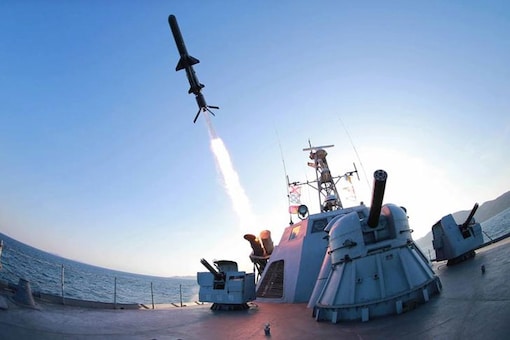The Indo-Israeli surface-to-air missile (SAM), Barak 8, is already in demand as reports surfaced, hinting Vietnamese interest. Operated by Azerbaijan, India, Israel and Morocco, the state-of-the-art combines the Indian and Israeli best practices and knowledge. In a vertical launching system (VLS) configuration, Barak 8 has been inducted by the Indian Navy as part of its Kolkata-class and Visakhapatnam-class destroyers, Nilgiri-class frigates and the INS Vikramaditya. The latest deployment by the Indian Navy will be as a 32-cell VLS on the INS Vikrant.
State-of-the-Art: Barak 8 Missile System
In a concerted effort by the Indian Defence Research and Development Organisation (DRDO) and Israeli Israel Aerospace Industries (IAI), the Barak 8 is produced by India’s Bharat Dynamics Limited (BDL) and Israel’s Directorate of Research and Development (DDR&D), Elta Systems and Rafael Advanced Defence Systems.
Barak 8 is loosely based on the Barak 1 missile, an Israeli short-range SAM (SRSAM) that carries a 22 KG payload up to 12 KM.
Marine and land-based systems come in medium-range SAM (MRSAM) and long-range SAM (LRSAM) variants. It delivers a 60 KG warhead up to Mach 3. It has 360-degree coverage, smokeless propulsion, thrust vector control, dual pulse propulsion, vertical launch and a two-way data link.
Notably, when combined with a modern air defence system like multifunction surveillance, track and guidance radars, Barak 8 can engage multiple targets simultaneously during saturation attacks. One such system can be the IAI Elta’s EL/M-2248 MF-STAR multifunction active electronically scanned array (AESA) radar atop the Kolkata-class destroyers of the Indian Navy.
The MRSAM has an advanced active radar radio frequency (RF) seeker that enables the detection of mobile targets under extreme weather. This seeker is housed in the missile head. The MRSAM has specific tweaks for an India-centric product. It also happens to be wholly indigenous. Another highlight is its thrust vector mechanism which has been under research and development for several years.
Anti-Access/Area Denied (A2/AD) Masterclass
By design, Barak 8 is meant to intercept various airborne threats such as aircraft, helicopters, anti-ship missiles, unmanned aerial vehicles (UAVs), ballistic missiles, cruise missiles and combat jets. This, combined with its operational range from 0.5 KM to 100 KM, transforms it into a formidable air defence system.
The maritime version of the Barak 8 is not only a protective measure but also plays a vital role in securing naval airspace.
A2/AD is a maritime strategy to deny naval forces freedom of movement in a battle space. As demonstrated by China in its naval backyards, the strategy uses various missile systems along with formidable surveillance and reconnaissance to engage adversarial vessels without needing to deploy as many of one’s ships.

Traditionally, the fleet of a navy works on sea denial. By placing certain vessels in specific locations, the calculus of risk deters the enemy from mobilising in those areas. However, drone swarms, mines, anti-ship missiles, etc., can put up a wrench in the plans. This form of conflict is what A2/AD defines.
The latest interest from Vietnam is precisely for this purpose. Recently, China violated the Exclusive Economic Zone (EEZ) of Vietnam during a military drill. This procurement would allow Vietnam to employ a Chinese tactic against them.
Now, this asymmetric warfare is especially useful in the current war-averse times because the calculus of risk becomes a deterrent enough. Meanwhile, any hit on the invincible naval vessel can be churned into a political victory.
In such an evolving battle on the seas, the addition of the Barak 8 maritime version is future-proofing our fleets.
Future Forward: Extended Range
The journey of Barak 8 has been an iterative one. When first unveiled, the range was only 70 KM, incrementally increasing to about 90 KM and 100 KM.
Vying for 150 KM, currently, the Barak 8 Extended Range (ER) is under development. The design objective is to engage multiple beyond visual range threats. Although components like the autopilot, inertial navigation system and active radar seeker guidance are likely to be retained, the software will be modified, and the missile will feature a longer booster. The length of the missile is expected to go up to 6 M.
The Barak 8 ER was tested by Israel, where it destroyed a target 150 KM away. The interceptor reaches up to 30 KM in altitude.
The Barak system provides an optimal response for deployment on the future battlefield. More so, it is on track to achieve similar success to the BrahMos in terms of defence exports for India. Over the years, Colombia, Finland, Germany, Poland, Saudi Arabia, United Arab Emirates and Vietnam have evinced interest.
